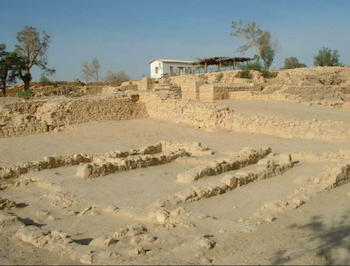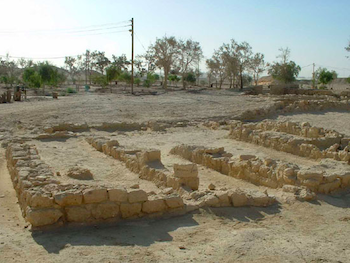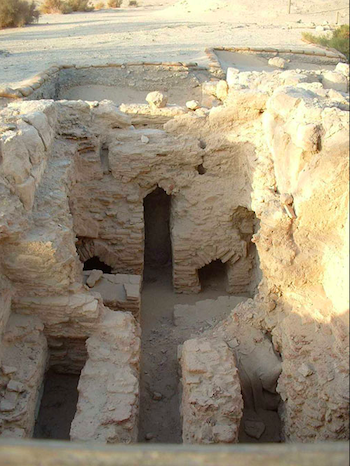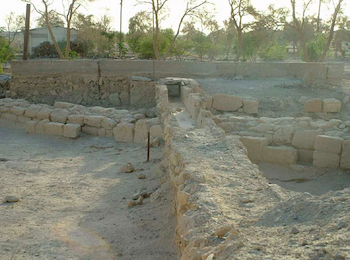By Matt VandeBunte
March 2004
 Excavation has uncovered no evidence of Christian settlement, but caretakers of Biblical Tamar Park point to the ancient city that they are bringing out of the desert as fundamental to their faith. A monotheistic bond with the Holy Land brought volunteers from Blossoming Rose to the Arava two decades ago. What they since have unearthed inspires them to keep working with the Israeli Antiquities Authority to reveal the history of the area known as En Hazeva.
Excavation has uncovered no evidence of Christian settlement, but caretakers of Biblical Tamar Park point to the ancient city that they are bringing out of the desert as fundamental to their faith. A monotheistic bond with the Holy Land brought volunteers from Blossoming Rose to the Arava two decades ago. What they since have unearthed inspires them to keep working with the Israeli Antiquities Authority to reveal the history of the area known as En Hazeva.
Founded in Michigan and made up largely of evangelical Christians, Blossoming Rose includes restoration of the Holy Land as part of its mission. Its supporters are motivated by what they see as a biblical mandate to bless Israel.[1] They say their findings in the desert shed light not only on the roots of the Jewish religion, but also lay a foundation for their own Christian beliefs.
The organization now seeks to share its discoveries by bringing the biblical city of Tamar back to prominence as a tourist destination.
“The foundational history of Christianity can only be found in its Hebraic roots,” says DeWayne Coxon, a pastor and former college administrator who founded Blossoming Rose in 1983. “Without Israel, we don’t have a historical basis for our Christianity. Without Israel, we haven’t got an intelligent understanding of what God is going to use Christians for in the world. Our role (at Blossoming Rose) is to be in the desert to prepare a place for the wayfaring stranger.”
What Blossoming Rose is exposing about the past illumines that which Coxon foresees in the future. The dig, which sits south of the Dead Sea on Highway 90, has yielded an assortment of distinctly Jewish artifacts that are indispensable to the Christian faith.
Perhaps the most telling find to date is a pit of Edomite cultic figures, apparently smashed and discarded in a single heap outside a city wall from the Late First Temple Period. Layers of large silex blocks from an earlier era form the corner of a rectangular fortress that features a gate complex similar to contemporary Israelite settlements during the reign of King Solomon.
 Excavation also has located a four-room house typical of Israelite settlements in the first millennia BCE. The 2004 archaeology season, which begins in March, will include digging and restoration of the 3,000-year old house. (The next season for digging will begin January 5, 2005.)
Excavation also has located a four-room house typical of Israelite settlements in the first millennia BCE. The 2004 archaeology season, which begins in March, will include digging and restoration of the 3,000-year old house. (The next season for digging will begin January 5, 2005.)
While the most recent remains at Tamar suggest that the area was a military and economic center under the Romans, earlier habitation yields evidence of pre-Christian monotheism central to the faith of Blossoming Rose volunteers and their Jewish kin.
“There is enough biblical evidence that the God of the Jews became the God of the Gentiles,” Coxon says. “We are to be a part of the glory of the people of Israel. I see enlightenment of the world coming through all monotheistic believers.”
Coxon was president of the former Jordan College in the late 1970s, when the Michigan school received government funding to explore renewable energy sources amid the oil crisis of the time. Seeking the hottest places he could find to test solar-powered greenhouses, Coxon traveled to Israel in 1979 and 1981 and came across the site of what is now Biblical Tamar Park.
Energy prices soon plummeted and interest in alternative energy waned, but Coxon remained drawn to the Holy Land. He saw in Israel an opportunity to obey the Old Testament scriptures that he believes command Gentile followers of God to bless the Jewish people.[2]
Sponsors who had given money to support energy research started paying the way for displaced Jews to make aliyah back to Israel. The effort “just became a project in itself,” Coxon said, and Blossoming Rose was born.
The Michigan ministry has headed a variety of humanitarian projects in Israel, such as setting up a dental clinic for Jews and Arab Christians at the Sisters of the Rosary Catholic Guest House in Jerusalem. But efforts have focused mostly on the twin mandate to return and restore. Blossoming Rose has sponsored the aliyah of Jews exposed to nuclear radiation at Chernobyl, and also paid for the return of Jews dispersed to Ethiopia and India. Restoration of the land has included plantings of trees in Eilat and grapevines in Ariel on the West Bank, planting roses and weeding in Wohl Rose Park near the Israeli political headquarters and revitalization of a neglected kibbutz.
Volunteers assisted the residents of Kibbutz Ir Ovot in planting crops and irrigating fields. In 1986, Coxon learned that the kibbutz was built atop the ancient biblical city of Tamar, constructed west of the En Hazeva spring that is one of the most abundant water sources in the central Arava. He saw excavation of the site as an opportunity to instill new life into the desert, per scripture.[3]
Now, Biblical Tamar Park is the top priority for Blossoming Rose, which counts more than 5,000 members worldwide and carries an annual budget of almost $500,000. It hosts symposiums that promote awareness stateside of sacred scriptures shared by both Christians and Jews. The organization also leads sightseeing tours of Israel and expeditions to the 53-acre Biblical Tamar Park.
The first salvage excavation at Tamar took place in 1972 under the direction of Rudolph Cohen. Subsequent digs have been conducted under the sponsorship of Blossoming Rose, in partnership with the Antiquities Authority, Jewish National Fund and the Tamar-Sapir Regional Council. The work has unearthed six strata:[4]

Archaeologists found a stratum of building fragments from the Early Arab Period immediately beneath the ground surface, as well as evidence of a farm above the remains of a Roman bathhouse. The remnants were located underneath existing modern structures, on top of Roman ruins.
Prior to Muslim habitation, Tamar appears to have been an active outpost on the frontier of the Roman world. Evidence of Roman administrative and military presence abounds, and the site likely served as an economic way station at the crossroads of busy trade routes – one that linked the Far East to the Mediterranean Sea and another that ran south through Tamar to the Red Sea.
The floor plan of the Roman Fortress at what was known as Tamara resembles that of other imperial outposts along the route from the Dead Sea to Eilat. A large limestone slab found at nearby Yotvata bears an official Latin inscription that dates that fort – and others like it, including the one at Tamar – to the time of the emperor Diocletian in the third century CE.
Measuring 46 meters square, the Tamara fortress was the largest of its kind in the Arava. Four projecting towers built on the corners of the stronghold date to the end of the third century CE. Artifacts from pottery to coins reveal that the fort was destroyed in the middle of the fourth century CE, perhaps by an earthquake in 344. It immediately was rebuilt – this time with stone floors instead of beaten earth – only to encounter destruction again two decades later, likely from an earthquake in 363.
 About 50 meters southeast of the Roman Fortress, excavation uncovered the remains of a bathhouse and a palaestra, or inn. The 45- by 40-meter complex dates to the third- and fourth-centuries CE, and appears to have the same floor plan as contemporary bathhouses at the Ashkelon and other nearby locales. An under-floor furnace heated pools and tubs via steam seeping up through clay tiles. The complex also featured a dressing room, cold-water pool and a sauna.
About 50 meters southeast of the Roman Fortress, excavation uncovered the remains of a bathhouse and a palaestra, or inn. The 45- by 40-meter complex dates to the third- and fourth-centuries CE, and appears to have the same floor plan as contemporary bathhouses at the Ashkelon and other nearby locales. An under-floor furnace heated pools and tubs via steam seeping up through clay tiles. The complex also featured a dressing room, cold-water pool and a sauna.
A row of rooms that formed part of an earlier fortress produced finds that date from the first century BCE to the first century CE, likely during a Nabataean Period of occupation prior to Roman annexation. Alongside storage jars and other vessels, archaeologists found coins – some bearing the likenesses of Nabataean kings.
Evidence suggests that Tamar at this time probably was an important trade link in the “Spice Route” that ran from the Far East through the Arabian peninsula to Gaza on the Mediterranean coast.
Several centuries before Tamar became a military base and hub of trade for imperial inhabitants, the city was distinctly Jewish. Excavations have uncovered ruins of three separate fortresses, from the tenth century BCE to the fall of the First Temple in 587 BCE.
“This place is more important for Jews than Masada, but there are many Jews that don’t know about this place because no one takes the information out of the desert,” says Asher Sofer, manager of Biblical Tamar Park. “Our vision here is to put Tamar city in the right…to make it what it deserves to be.”
The earliest remains date to the First Temple Period, during the reign of King Solomon over a united monarchy in the mid-tenth century BCE. They were found about 3.5 meters below the ground surface, with the southwestern corner of a rectangular structure measuring 13- by 11.5-meters preserved to a height of more than one meter.
The fortress resembles contemporary strongholds in the Negev highlands, and offered up a clay cooking pot known as “Negbite” ware. The style, which dates from the tenth to sixth centuries BCE, also has been found at Tel Qadesh Barnea and Tel el-Kheleifeh. It is likely that the first fortress at Tamar met the same fate as many of its peers – destruction at the hands of Pharaoh Shishak at the end of the tenth century BCE.
Above the earliest structure, archaeologists uncovered a much larger Iron Age fortress surrounded by a casemate wall. Covering about 10,000 square-meters, this bastion from the Judean Kingdom of the First Temple Period is four times the size of other Negev fortresses and nearly as large as contemporary cities such as Tel Beersheba. Its sheer size and north-facing gate suggest that Tamar at this time was a fortified city, rather than solely a military outpost.
 The four-chambered gate complex located near the northeastern corner was preserved to about three meters, and features four 2.5-meter wide gate piers. Excavation also has revealed three storerooms measuring 17 meters long and 2 meters wide, a pair of granaries and a rampart and moat.
The four-chambered gate complex located near the northeastern corner was preserved to about three meters, and features four 2.5-meter wide gate piers. Excavation also has revealed three storerooms measuring 17 meters long and 2 meters wide, a pair of granaries and a rampart and moat.
It is uncertain who built this city or how it was destroyed. Likely candidates for construction include eighth-century BCE King Amaziah – who fortified the Judean kingdom and went to war with neighboring Edom in the northern Arava – and his son, Uzziah – whom II Chronicles mentions for building towers in the desert. Destruction may have come by an earthquake foretold by the prophet Amos, or through conflict with Edom.
More than a century after fortified Tamar city met its fate, a third fortress appeared during the Late First Temple Period in the seventh- and sixth-centuries BCE. Only the foundations of the walls remain in most places, making it difficult to reconstruct the floor plan. But excavations have restored the eastern wall with two towers set 14 meters apart. Southeastern and northeastern towers also have been uncovered.
Most intriguing about this third temple, however, is a pit full of smashed clay and stone pieces that have been reassembled into 74 cultic vessels that likely made up an Edomite shrine. The incense burners, chalices, altars and human figurines were found in 1993 on the northern edge of the site outside the fortress wall near the foundations of a small building that seems to have been a shrine.
Some of the shards, especially three anthropomorphic stands, are similar to vessels found in an Edomite shrine at Horvat Qitmit, about 45 kilometers to the northwest. A circular stone seal discovered inside the fortress provides another indicator of Edomite origin. The seal – on which is engraved two bearded male figures dressed in long robes and standing on either side of an altar – measures 15 millimeters thick and 22 millimeters wide. It has been identified as Edomite and may have belonged to a priest that served in the shrine.
The artifacts from the pit date to the end of the seventh century and may have been destroyed by King Josiah as part of religious reforms mentioned in II Kings. Because the pieces were found in situ, it is probable that they were deliberately smashed and discarded.
As excavation continues, future plans for Biblical Tamar Park include building an educational center for Christians and Jews with a museum, a welcome center gift shop and a restaurant. Blossoming Rose volunteers already have installed display lighting and drip irrigation for landscaping. They now are helping to install a security fence around the site.
Existing buildings on site include a 24- by 60-foot air-conditioned dining hall, bomb shelter, utility building, office and seven house trailers where volunteers stay. With a welcome center, the park could sell memorabilia and refreshments to fund a self-paced walking tour with a multi-language sound system for tourists. The current office atop the Tel would be transformed into a display space for artifacts.
“There are many valuable items that we have found here, but there is no place that we can show them,” Sofer said. “The vision is to let people see what happened here 3,000 years ago. What’s important is the fact that Jewish people were here.”
Sofer directs volunteers as they assist archaeologists in preparing the area surrounding the dig for the arrival of visitors. Tasks include landscaping, placing sandbags around the dig to stop erosion and maintenance of facilities.
“It’s neat to see things come to fruition,” said Tristan Macauley, a 22-year old University of Pittsburgh student who arrived at Biblical Tamar Park for the fourth time in October and plans to stay through April. “This dig is incredibly important because of the historical things that happened here.
“It’s a place of light compared to all the darkness that’s going on in the country right now.”
The next archaeology season at Biblical Tamar Park is scheduled for January 3-21, 2005. The cost of the 3-week season is $1800, and the Jordan (Petra) add-on is $400. Blossoming Rose leads several tours each year to Israel and the dig, where tourists spend a week working on site. Visit Blossoming Rose online or email at: info@blossomingrose.org for more information.
NOTES
[1] “They will renew the ruined cities that have been devastated for generations. Strangers will shepherd your flock; foreigners will work your fields and vineyards.” -Isaiah 61:4-5.
[2] “I will lift up mine hand to the Gentiles, and set up a standard to the people; and they shall bring thy sons in their arms and thy daughters shall be carried upon their shoulders.” -Isaiah 49:22.
[3] “The Arava shall rejoice and blossom as the rose.” -Isaiah 35:1.
[4] Descriptions of the dig at Biblical Tamar Park rely heavily on the reports of archaeologists Rudolph Cohen and Yigal Yisrael as published in “On the Road to Edom: Discoveries from En Hazeva.” The Israel Museum, Jerusalem. 1995.
